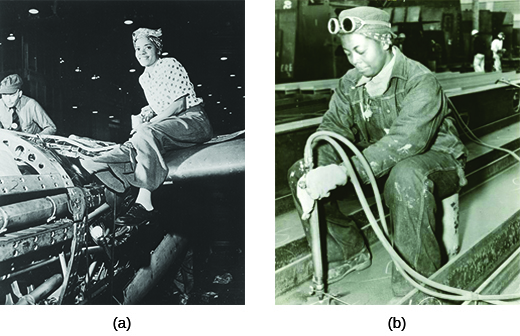| << Chapter < Page | Chapter >> Page > |
View an excerpt from a PBS documentary on rationing during World War II.
Civilians on the home front also recycled, conserved, and participated in scrap drives to collect items needed for the production of war materiel. Housewives saved cooking fats, needed to produce explosives. Children collected scrap metal, paper, rubber, silk, nylon, and old rags. Some children sacrificed beloved metal toys in order to “win the war.” Civilian volunteers, trained to recognize enemy aircraft, watched the skies along the coasts and on the borders.
As in the previous war, the gap in the labor force created by departing soldiers meant opportunities for women. In particular, World War II led many to take jobs in defense plants and factories around the country. For many women, these jobs provided unprecedented opportunities to move into occupations previously thought of as exclusive to men, especially the aircraft industry, where a majority of workers were composed of women by 1943. Most women in the labor force did not work in the defense industry, however. The majority took over other factory jobs that had been held by men. Many took positions in offices as well. As white women, many of whom had been in the workforce before the war, moved into these more highly paid positions, African American women, most of whom had previously been limited to domestic service, took over white women’s lower-paying positions in factories; some were also hired by defense plants, however. Although women often earned more money than ever before, it was still far less than men received for doing the same jobs. Nevertheless, many achieved a degree of financial self-reliance that was enticing. By 1944, as many as 33 percent of the women working in the defense industries were mothers and worked “double-day” shifts—one at the plant and one at home.
Still, there was some resistance to women going to work in such a male-dominated environment. In order to recruit women for factory jobs, the government created a propaganda campaign centered on a now-iconic figure known as Rosie the Riveter ( [link] ). Rosie, who was a composite based on several real women, was most famously depicted by American illustrator Norman Rockwell. Rosie was tough yet feminine. To reassure men that the demands of war would not make women too masculine, some factories gave female employees lessons in how to apply makeup, and cosmetics were never rationed during the war. Elizabeth Arden even created a special red lipstick for use by women reservists in the Marine Corps.

Although many saw the entry of women into the workforce as a positive thing, they also acknowledged that working women, especially mothers, faced great challenges. To try to address the dual role of women as workers and mothers, Eleanor Roosevelt urged her husband to approve the first U.S. government childcare facilities under the Community Facilities Act of 1942. Eventually, seven centers, servicing 105,000 children, were built. The First Lady also urged industry leaders like Henry Kaiser to build model childcare facilities for their workers. Still, these efforts did not meet the full need for childcare for working mothers.

Notification Switch
Would you like to follow the 'U.s. history' conversation and receive update notifications?